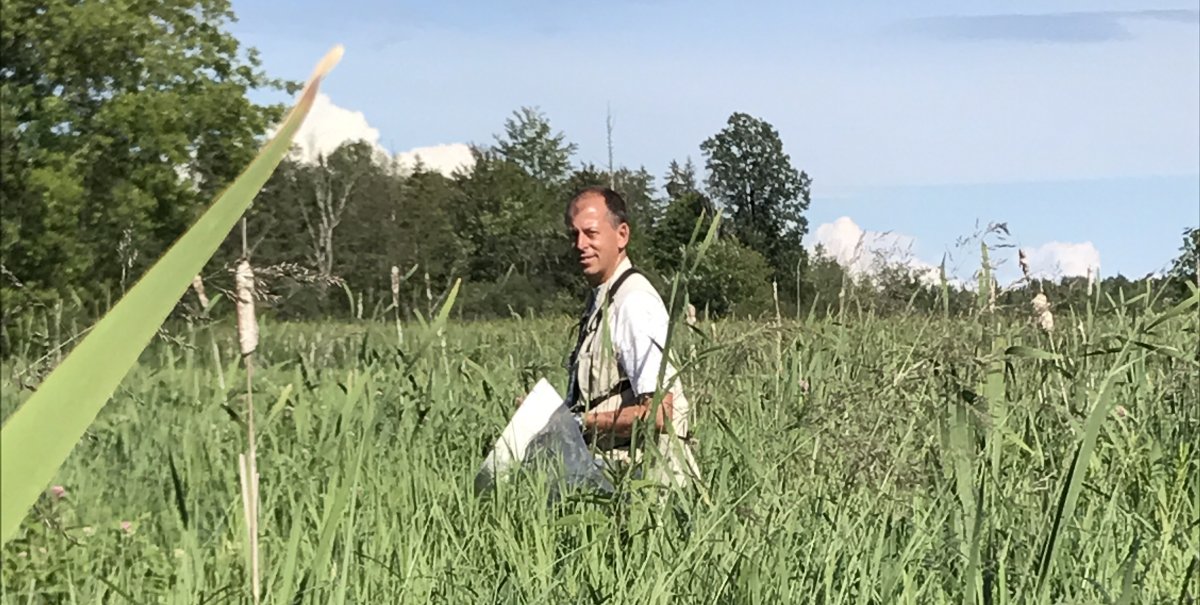by Sandy Garland

Notes on a talk by Dr. Jeff Skevington, Agriculture and Agri-food Canada, 14 September 2017
Jeff started by showing us a number of newspaper and magazine stories about bees that have featured a photo of a fly by mistake. Bees are what we think of when someone says pollinator, while flies go unrecognized for themselves or their importance as pollinators. For our agricultural crops, 39% are pollinated by honey bees, 23% by native bees, and 38% by other pollinators, most of which are flies.
Flies are less efficient at pollination than bees, but make up for that by visiting flowers more often. They travel farther than bees, thus increasing the chance of out-crossing (moving pollen between plant populations). They also do not “steal,” i.e., eat pollen, so are more likely to transfer it to another plant.
Flies are active at different times of the day and year and at different temperatures than bees. For example, hover flies are often active very early in the season and will fly on cool rainy days when bees don’t. There are 550 species of hover flies in Canada, making them the largest group of non-bee pollinators.
Non-bee pollinators get little attention. In a project Jeff was involved in recently, 200 scientists were studying pollinators; only 5 or 6 were looking at non-bees.
What is a fly?
Here are some clues to distinguishing flies from bees:
- flies have one pair of wings instead of two like bees; the other pair are halteres, which act as gyroscopes allowing flies to manoeuvre when flying
- adult flies have sucking mouth parts as they eat nectar
- fly larvae are simple and have no legs
- flies’ heads are almost entirely eye, whereas bees usually have a space between their eyes
- the antennae of flies are usually very short; bees’ are longer and bent
Families
The families of pollinating flies are all among the top fly families in terms of numbers of species.
Tachinidae – Bristle flies
Have bristles, a “spare tire” under their scutellum, and are parasitoids.
Bombyliidae – Bee flies
Important pollinators in arid and semi-arid areas. Come out in early spring to visit the first flowers. As larvae, they attack bees and wasps. Good at hovering.
Empididae – Dance flies
Tiny, so important pollinators of tiny flowers. Both larvae and adults are predators. When mating, males present females with a silk ball, sometimes containing prey. Sometimes females also give a present to males.
Muscidae – House flies
Important pollinators in the Arctic and in early spring.
Calliphoridae – Cluster flies and blow flies
Cluster flies are predators on earthworms; these species are not native. Blow fly adults visit flowers; most are metallic.
Syrphidae – Flower or hover flies
Not found in dry areas; prefer moist habitat. Attack aphids. Visual key to the 76 genera – https://cjai.biologicalsurvey.ca/mylmst_23/mylmst_23_1.HTM
Ecology
Not only are these flies good pollinators, but, according to Jeff, they may also be useful as decomposers and in sewage treatment.
Supplementary information
Pollinator flies found at the FWG (* means non-native; diamond indicates species found during bioblitz in 1996, but not since)
| Bombyliidae | Bee flies |
| Bombylius sp. | Bee fly |
| Bombylius major | Bee fly |
| Exoprosopa decora | Bee fly |
| Poecilanthrax tegminipennis | Bee fly |
| Sparnopolius confusus | Bee fly |
| Villa cf. alternata | Bee fly |
| Calliphoridae | Blow flies |
| ♦Calliphoridae, several spp. | Blow flies |
| Lucilia sp. | Greenbottle fly |
| Conopidae | Thick-headed flies |
| Physocephala sp. | Thick-headed fly |
| Zodion sp. | Thick-headed fly |
| Zodion intermedium | Thick-headed fly |
| Empididae | Dance flies |
| ♦Platypalpus sp. | Dance fly |
| Rhamphomyia longicauda | Dance Fly |
| Muscidae | Muscid flies |
| *Coenosia tigrina | Muscoid fly |
| ♦Lispi sociabilis | Muscoid fly |
| Muscina assimilis | Muscoid fly |
| ♦Schaenomyza litorella | Muscoid fly |
| Syrphidae | Flower flies or hover flies |
| Allograpta obliqua | Hover fly |
| Chalcosyrphus curvaria | Hover fly |
| Epistrophe sp. | Hover fly |
| Eristalis sp. | Hover fly |
| Eristalis arbustorum | Hover fly |
| Eristalis dimidiata? | Hover fly |
| Eristalis flavipes | Hover fly |
| Eristalis tenax | Hover fly |
| Eristalis transversa | Hover fly |
| Eupeodes sp. | Hover fly |
| Helophilus sp. | Hover fly |
| ♦Lejops lineatus | Hover fly |
| Lejops subgenus Anasimyia | Hover fly |
| Melangyna lasiophthalma | Hover fly |
| ♦Paragus angustifrons | Hover fly |
| ♦Parhelophilus laetus | Hover fly |
| ♦Platycheirus quadratus | Hover fly |
| Somula decora | Hover fly |
| Sphaerophoria sp. | Hover fly |
| Spilomyia longicornis | Hover fly |
| Spilomyia sayi | Hover fly |
| Syrphus sp. | Hover fly |
| *Syritta pipiens | Hover fly |
| Temnostoma alternans | Hover fly |
| Temnostoma balyras | Hover fly |
| Temnostoma barberi | Hover fly |
| Toxomerus geminatus | Hover fly |
| Toxomerus marginatus | Syrphid fly |
| Tachinidae | Parasitic flies |
| ♦Cryptomeigenia simplex | Parasitic fly |
| Cylindromyia interrupta | Parasitic fly |
| Gymnosoma sp. | Parasitic fly |
| Hemyda aurata | Parasitic fly |
| ♦Panzeria sp. | Parasitic fly |
| ♦Parasetigena silvestris | Parasitic fly |
| ♦Winthemia quadripustulata | Parasitic fly |